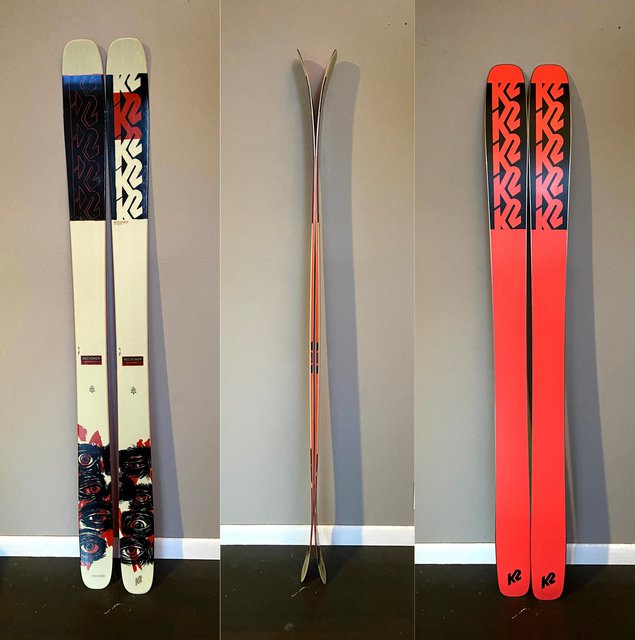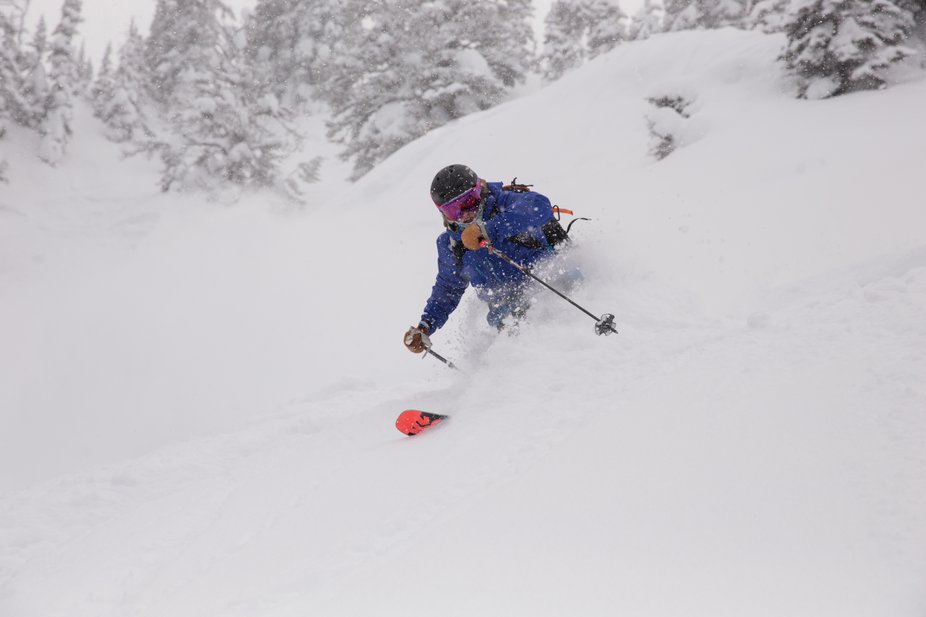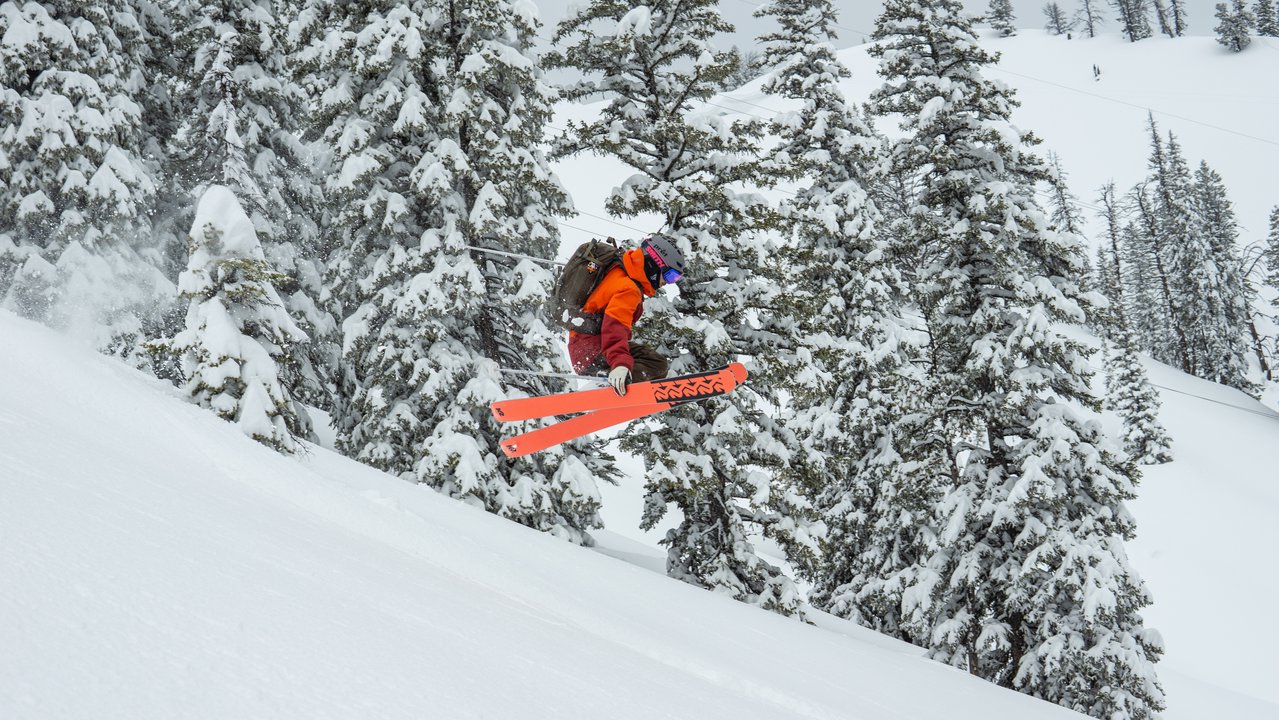Ski: K2 Reckoner 112
Length skied: 184cm
Actual Length (Tip-tail w/ straight tape): 184.5cm
Measured weight (each ski): 1991/2048 grams
Shape: 136-112-127
Sidecut: 22.9 meters
Mount: “midsole” -5.5cm from center (tested here)
“Team”: -3.5 cm from center
Binding: Cast Freetour/ Pivot 18.
Days skied: 15
Review Location: Jackson Hole Mountain Resort and Backcountry
Conditions skied: Touring, pow, groomers, corn, slush.
[Editor's note: Our review was conducted on the 2021 K2 Reckoner 112, which is unchanged for 2022 & 2023 except for graphics]
I, Erica [EA] and my boyfriend Dylan [DD] are Jackson Hole, Wyoming based skiers. We're fortunate enough to be able to share equipment, and therefore are bringing a double perspective to the powder and big mountain ski Roofbox Reviews on Newschoolers. When applicable, our individual opinions are noted with our initials.
_________________
The Reckoner line up is a new line from K2 skis, the line includes a 102mm waisted ski, the 112mm waist ski tested here, and a 122mm waisted model. This line of skis borrows a lot from the Mindbender series released by K2 last season but differs in the fact that the Reckoners come in different waist widths, have a twin tail with more tail rocker and more centered mounting points. The Reckoners also share attributes with the previous twin-tip models from K2 but bring the weights down significantly, ditch the asymmetric sidecuts of the Catamaran and Marksman, and reintroduce sidecuts more similar to the Shredditor series that was the twin tip line before the asymmetric skis.
K2 says introduces the Reckoner 112 like this:
“You know that ski you want for every occasion? The ski that jumps, slarves, slashes, and cuts. The ski that can bounce pillows to the ground floor, hit jumps late into the afternoon sun, and snipe transitions when the pow has been tracked: The Reckoner 112.”
K2 is really emphasizing the playfulness and versatility of this ski, which is no surprise given it sits in the middle of the Reckoner line up. With a 112mm waist, it’s a nice middle ground between a pow ski and a park ski, and the lighter weight should help keep it playful at lower speeds.
_

Shape/Flex/Construction:
The 112 has a lot of tip taper compared to most other skis in this category, the taper is long, but doesn’t taper super aggressively to a point, it is more like a long straight section that only narrows a little bit. The rocker lines are deep in the tip and slightly less deep in the tail, and the profile is smooth with no aggressive curves, the rocker height doesn’t seem out of the ordinary, and there are a few millimeters of camber underfoot that is pretty typical for a ski of this nature.
The Construction is similar to what most companies are going to with a partial sidewall underfoot and cap construction in the tips and tails to save weight. The most interesting part of the Reckoner construction is the carbon weave that varies density along the length of the ski. The tip and tail have a less dense weave to allow more torsional flex that allows the ski to be easier to break free and drift. Underfoot the weave is tighter to provide better edge hold in firm snow. Besides this carbon weave, which they call “spectral braid”, the Reckoners feature K2's standard aspen and fir core, the base and edge dimensions aren’t specified. They aren’t exceptionally thin, but they don’t seem as thick as an ON3P (Twig's note: I think they a 2.5x2.2mm but don't lynch me if I'm wrong).
The flex of this ski is definitely on the playful side of the spectrum, the tips and tails are pretty soft, but the stiffness quickly ramps up to a stout center of the ski. The transition isn’t the smoothest between the soft extremities and the stiff underfoot section, which will have some downfalls in certain conditions but should make it easy to access the tips and tails for butters and presses. I would say that the tips are a 5.5/10 quickly transitioning to an 8/10 at the rocker line, and then getting slightly stiffer right underfoot to a 8.5-9/10, the tails have a similar flex profile but are slightly stiffer, I’d rate them at a 6-6.5/10 also quickly transitioning to an 8-8.5/10 at the rocker line.
_
On Snow Performance:
On my first run on firm snow with these, I was very surprised by the hooky nature of the skis and had difficulty breaking them free. I found this strange because the amount of taper and tail rocker should make them very easy to ski. I kept catching the tails in technical zones even after detuning them much more than I typically do. This led to some very exciting skiing and basically zero confidence during my first day. After taking them into the shop, we put a true bar on them– turns out the skis were super railed, which means that the base was higher than the edge. The ski was concave from tip to tail instead of being flat, (some powder oriented ski have convex bases in the tips and tail). After quite a few passes through the tuning machine the skis were now flat, and had a finer base pattern that allowed it to release a little easier, the tails were detuned, the bases waxed, and the rest of the review will cover what our thoughts were after fixing the base. I can’t say if this issue was just because we got an early production pair of skis or if K2 skis are known to come railed from the factory, but it is something to be on the lookout for. This isn’t a huge deal, a lot of skis are not flat out of the factory, and any decent shop will grind them flat if you ask to have them checked.
_
Groomed trails:
[DD] Once the bases were flat the review could commence in earnest. These skis were a little harder to rip good carves on groomers than other skis of similar waist widths. The longer turn radius didn’t engage particularly easily until a higher speeds were reached, and the heavily tapered tips didn’t initiate a turn as well as skis with less taper. However, carving performance isn’t high on my priority list for a soft snow oriented ski so this wasn’t an issue for me personally. Once the speeds got a little higher I could easily get these things railing turns and they provided a lot of energy for between turns. They aren't a groomer ski but they will get you around the mountain just fine.
_
Steeps:
[DD] Once the tails stopped catching, the Reckoners handled steeps adequately. I found that they rewarded a more centered stance. On occasions where I got kicked backseat the softer tails flexed out a little and so they didn’t provide a great platform for really confident skiing in the steepest terrain. When a more centered stance was maintained and the snow was soft, the tails weren’t an issue at all and the longer turn radius didn’t try to pull you across the fall line when engaging the edges like some skis with a shorter turn radius will tend to do. The Reckoners rewarded being skied with precision, you could pick them up at any point and transfer to a different line very easily. As long as you were nimble on your feet, which isn’t hard considering how light they felt on my feet, you could let the Reckoners run out the bottom with some pretty serious speed without worrying about the ski getting twitchy and scary.
[EA] I had a very similar experience to Dylan here in that while maintaining a centered stance, the skis were solid, especially in more wide-open terrain. When straight-lining out of a feature there were no issues in worrying about the stability of the ski. However, while navigating tighter terrain I ran into trouble initiating quick turns with any ease.
_
Powder/Float:
At 112 underfoot with a long tip rocker it shouldn’t be surprising that this ski really shines in pow. At slow speeds, it doesn’t provide the float of the super-wide powder specific skis like the Pon2oon or the Bentchetler 120, but there is a wider Reckoner 122 designed more for those conditions. When you pick up a little bit of speed on the Reckoner 112’s they get up on plane, much like a boat does, and then the skis become incredibly nimble. The light swing weight makes it effortless to change direction and you can preload the tail and get a lot of pop out of them off of pretty much any feature you can find, even when trying to ollie out of practically bottomless snow.
In consistent, soft snow these skis seemed to have no speed limit and the faster you went the more you could bounce around and make any minor bump in terrain into an air that can be boosted. The long turn radius combined with the taper made for a ski that had no issues catching in slightly wind affected powder even at speed. The swing weight seemed even lower than the already light weight would suggest, I was tweaking shifties and safety grabs were coming up easier than normal. I did a few nose butters in pow on these and found that the lack of catching in the tail that I noticed earlier made for a super easy buttering experience, It was pretty effortless to set the butter and get up on the rockered portion of the ski without the tails catching at 90 and sending me onto my side like I have done many times before.

Photo by Shannon Corsi
_
Mixed conditions:
Mixed conditions are not the ideal snow conditions for the Reckoners, they are fairly lightweight with soft extremities that don’t let you just sit on the skis and plow through chunkier snow like true charging skis do. The Reckoners don't absorb a lot of vibrations from the snow and have a tendency to pop off things they hit rather than go through them. They prefer to ski mixed conditions in a more dynamic centered style where you are constantly popping off of every bump and sniping transitions, landing on other bumps etc. This technique is extremely fun but also tiring after doing it for a whole day. I preferred to take the Reckoners out on days where soft snow was the name of the game. In softer crud the Reckoners were awesome and rewarded the same active and precise style as in pow. They aren’t a traditional charging ski that can bust crappy conditions, but they do very well when popping around and trying to ski as playful as possible in softer chopped up snow.
_
Park/Playfulness:
This is where the Reckoner 112 shines. I haven’t skied a lot of park on it and when I did, I only hit jumps, but the light swing weight made them easy to spring and flip and the stiffer center section of the ski provided a solid landing platform. I found the tips and tails surprisingly easy to get onto for butters and tail presses. I took off and landed switch in the park as well as hit a few cat tracks switch and didn’t experience any weird catching.
In terms of all-mountain playfulness, these came alive when the speeds picked up and the snow was soft, I found myself looking for sniper landings all over the mountain and cat tracks to butter off. There was a surprising amount of pop out of the tails and I found myself overshooting the gaps I was trying to do when switching to the Reckoners after using other skis. After adjusting to this, they allowed me to either come in with less speed to make the same gap or pop extra hard and turn a double mogul gap into a triple. The Reckoner 112 seems to be a good blend of nimbleness when required and also having a high-speed limit when you get on top of that perfect line. It feels like the whole mountain is now your terrain park, which may seem cliche but it is a pretty accurate description, the ski encourages jibbing and proves to be damn good at it.
http://instagram.com/p/B_VZVl0jpzY/
Durability:
We’re happy to report no top sheet issues, no edge delamination, and no unwarranted base damage. We will update this if any durability issues pop up.
_
Comparisons:
K2 Reckoner 112 vs. Lib Tech UFO 115 :
The Reckoner 112 and the LibTech UFO 115 are close to identical in weight and built for similar purposes but have slightly different shapes and features. The UFO 115s have about 3m less sidecut than the Reckoners, making them more maneuverable on steep and tight terrain. The wider tips of the UFOs (146mm LT vs. 136mm K2) also made them float better when getting into deeper 8”+ of fresh snow. The Reckoners definitely outdo the Lib Techs when it comes to playfulness, I felt the urge to jump off of everything and find transitions, and the softer tips and tails lean into this key feature. Although we don’t do a lot of park skiing, if you’re looking for something to bring you back to the frontside of the mountain for some park laps at the end of the day, you’ll have more luck on the K2s in doing so.
_
K2 Reckoner 112 vs. Line Vision 118:
The Reckoner is narrower than the Vision but also weighs a bit more. Additionally, the tips and tails of the Reckoner are softer. I felt that the Reckoner was a little more oriented towards tricks than the Vision is. The softer tips and tails of the Reckoner lead to a ski that is pretty easy to butter once you lean into the softer sections of the ski. Because of the softer flex and what seemed to be not as damp construction, I found the Reckoner to get a little more unsettled in rougher firm snow, but if the snow was at all soft the skis were pretty comparable. The Reckoner needs a little more speed to get itself up on top of the snow due to being narrower. There is significantly more taper in the tips and tails of the Reckoner 112 which meant it dealt with wind crust a little better than the Vision 118 did, the tails seemed to catch less when the snow was extremely grabby and the tip cut through the crust better than the fat tip on the Visions. Both skis are suitable in-bounds pow day skis or heavier touring skis, again I would say the Vision suits a more directional skier while the Reckoner would lend itself to more switch skiing or someones who wants a one-ski-quiver since 112 is a little more reasonable to ski every day than the 118 waist of the Vision.
_
Conclusion:
Considering this ski’s best traits are its playfulness in soft snow I would recommend it to a person who skis a lot of park and is trying to bring some of those tricks onto the mountain during the soft days. It could also work for anyone who is more interested in jibbing around the whole mountain and finding every last side hit instead of going as fast as you can once the soft snow gets chopped up. For someone on the west coast who prefers a playful ski, it’s a blast in soft snow and also very fun in the park. Really the only downside is that it isn’t a very damp ski, but the sacrifice in rough snow performance comes with the benefit of extra pop and light weight. The Reckoner would serve as a good side country ski with a 50/50 binding like the Cast Freetour, Shift, or Duke PT, I wouldn’t want to do super long days with a lot of vertical with these on my feet but I would be happy to have them on short skins accessed by lifts, cars or snowmobiles.


Comments